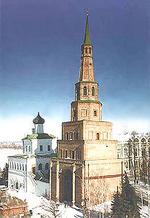| OVERVIEW |
 |
|
|
|
|
|
| Mail service |
 |
|
|
|
| Counters |
 |
|
|
|
| The best site 2004 |
 |
|

|
   |
|
|
The Suyumbike Tower

The Suyumbike Tower in the complex of the Governor's Palace is the historical pearl and the architectural symbol of Kazan. Its name is linked to the last queen of the Kazan Khanate Suyumbike, the wife of the two last khans of Kazan. It is 58 metres high, has seven tiers and is built of red brick. The three lower tetrahedrons go up in steps and are bordered by open terraces. The first tier has an archway, therefore the tower served as the passageway to the inner court of the commandant's house, which came to supplant the old 'khan's court'. Two octahedrons built upon the tetrahedrons are covered with a tented roof with a lantern watchtower topped by a spire. Brick vaults cover the rooms in the upper tetrahedron and the first octahedron.
Interestingly, the Suyumbike is one of the world's leaning towers - currently its inclination is 1.8 metres.
The origin of the tower is still a matter of controversy. Although it is considered to have been built around the second half of the 17th and beginning of the 18th century, there are, in fact, no surviving records in the Russian and Kazan annals of the construction of such an expensive building which lacked any specific purpose. The debate is linked to the veil of mystery, which still shrouds the historical architecture of the Kremlin, as well as the unceasing desire of scholars and architects to imagine how the Kremlin might have looked in the times of the Kazan khans.
It is well known that Ivan the Terrible's order to reconstruct the Kazan Kremlin was carried out from 1552 on, by the Pskov masons Postnik Yakovlev and Ivan Shiryai. It was through their efforts that the Kremlin acquired stone masonry executed in the old Russian style and which remains intact today. It is remarkable, however, that simultaneously with the building of the walls and towers of the Kazan Kremlin, the same Russian architects built in Moscow's Red Square the church of the 'Protection-on-the-Ditch' (Pokrova-na-rvu), otherwise known as the temple of Vasily Blazhennyi. The clear influence of the Oriental tradition embodied in the architectural design of this church has made some historians, in particular M. Khudyakov, speculate whether the architectural composition of the temple of Vasily Blazhennyi is, in fact, a replica of some vanished pearl of Kazan-Tatar architecture. Could it be that the architectural design of this church, dedicated to the fall of Kazan, was inspired by the long-lost architectural solutions of the main cathedral mosque of Kazan - the Kul Sharif mosque with its eight cupolas?
The lack of architectural paradigm and direct stylistic analogues for the Pokrov Church in old Russian architecture makes this question all the more essential. The impact of the Tatar architecture on Russian architecture was clearly seen earlier in other old Russian architectural monuments like the Church of Ascension in Kolomenskoye (1532), the church in Dyakovo near Moscow (1547) and the church in the village of Ostrov in the same period. It is, therefore, quite plausible that in the magnificent grandeur of the temple of Vasily Blazhennyi and other old Russian buildings of the 16th century we in fact see the reflection of the lost splendour of the ancient architecture of the Kazan Kremlin.
The architectural secrets of the temple of Vasily Blazhennyi give historical charm to meditations about the Kazan Kremlin. The same charm is felt in the mystery of another medieval construction - the Suyumbike Tower. Through its precise forms, the entire architectural concept and the standard of its bricks the influence of the Italian Quattrocento is clearly seen, and this suggests that it may have been designed by Italian architects who, in the second half of the 15th century, designed and built the Moscow Kremlin.
The main objection to the idea of the tower being constructed in the 15th century is the fact of the demolition of the Tatar architectural heritage after Kazan was captured by the Russian troops. And yet, if the tower, according to one hypothesis, was erected from an Italian design in 1487-1490 in honour of the conclusion of the treaty of 'eternal peace' between Khan Muhammad Amin and the Grand Duke of Muscovy Ivan the Third, which forever ended the tradition of Moscow paying tribute to Kazan, its preservation in the compound of the Kazan Kremlin would have been seen by Ivan the Terrible as a redoubtable symbol of the historical continuity of Moscow's dominance over Kazan. Moreover, the size of the bricks, of which the tower is built, does not correspond to the standard adopted by Russia in the times of Tsar Boris Godunov (at the end of 16th century), yet corresponds to the Italian standard introduced into Russia by the builder of the Moscow Kremlin, Aristotle Fioravanti. It has long been suggested that Italian masons were involved in the construction of the Kazan - why should we not go a little further and suggest that the Suyumbike Tower, without precedent in traditional Russian architecture yet so neatly matching the architectural legacy of Tatar masonry and of the Italian Renaissance, is of Lombard origin?
Today, this idea owes more to the art of speculation than to concrete scientific fact, and yet as time passes, more and more evidence has come to light which supports such a hypothesis. |
|
|
|
|
|
Traveller's view  |
|
|
| Thu Apr 25 |
| night / day: | °/°C |
 |
|
| Fri Apr 26 |
| night / day: | °/°C |
 |
|
|
|
|
|
Central Bank rates
|
|
 Dollar USA
Dollar USA
|

|
 Euro
Euro
|

|
|
| Navigation |
 |
|
|
|
| Search |
 |
|
|
|
|


